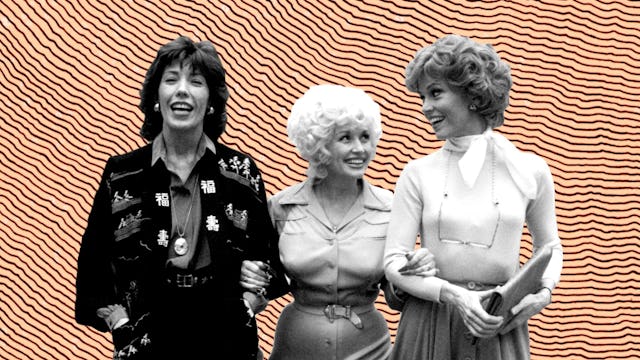‘9 to 5,’ turned the drive for worker's rights into a farce. But the real takeaway is how revolutionary its workplace vision really was.


Forty years later, we're still far from the workplace revolution of ‘9 to 5’
The first time I watched 9 to 5, the iconic 1980 workplace comedy starring Jane Fonda, Dolly Parton, and Lily Tomlin, I was electrified. I was in my early 20s, working my first real job after college as a reporter and being disabused of my romantic notions of office life. Like other naive millenials I believed that work was supposed to be a primary source of fulfillment in my life. I hadn’t accounted for the persistent disappointments and injustices of an entry-level job, or even more insidious, the poisonous power dynamics that require the lowest-level workers to spend their time managing the egos of their overlords.
9 to 5 was a revelation. My problems weren’t just mine, they were decades in the making. The film, about a trio of female office workers who exact revenge on their cartoonishly evil male boss, was made in an era when the workplace was being transformed by droves of women joining for the first time. Remarkably, it was eerily prescient about the problems that would plague working women for decades to come.
We are once again at an inflection point in the workplace. The pandemic has muted some of the old office power struggles and theatrics as many have shifted to remote work, as well as spawning new tyrannies. Still, workers are exercising real leverage over employers for the first time in a generation, taking advantage of current market conditions to demand higher pay and more flexibility, and withholding their labor until they get it. Watching 9 to 5 again in this moment of transformation, reveals how the film was an absurdist premonition for the way things could be if workers held the line for themselves as fiercely as their employers guarded their bottom lines.
How could so many of our grievances remain stubbornly the same?
In the movie, Franklin Hart Jr. oversees a firm of underpaid, undervalued women clerical workers. Frank quickly checks off a litany of priggish behavior: he sends his subordinates to fetch his coffee, calls them his “girls,” and goes on long stemwinders about teamwork. That’s before you get to the more serious stuff: he organizes the pens on his desk so that they easily topple over and his assistant, Doralee, played by Dolly Parton, will have to bend down to pick them up and he can look down her shirt. Frank blithely takes credit for the work of Violet, a hypercompetent supervisor played by Lily Tomlin, before passing her over for a promotion and giving it to a man who has “a family to support.” (Violet is a single mother herself.). He fires women for sharing their salaries and despises unions. He’s so cruel to Judy, the wide-eyed, nervous divorcee played by Jane Fonda, that he brings her to tears on her first day.
After setting up these miserable working conditions, 9 to 5 devolves into goofy, pot-induced reveries as the three women fantasize about how they might murder Frank. (Violet, dressed as a Disney princess and assisted by cartoon birds, opts to poison him; Doralee chooses to barbecue him on a spit; Judy imagines hunting him like wild game). Fantasy brushes too close to reality when Violet accidentally puts rat poison in Frank’s coffee, which doesn’t kill him but does necessitate an even wilder plot in which the women kidnap Frank and take over the company until they can figure out what to do with him.
9 to 5 is, to be clear, insane. But it was also canny about the forces that kept women economically hemmed in and unable to advance. The film drew from the real-life experiences of an association of office secretaries, also called “9to5”, which had been organizing and agitating for better working conditions across the country in the 1970s. As chronicled in a 2019 documentary, Fonda met with members of the Cleveland chapter when the film was in development and asked a pointed question: “Do any of you ever fantasize about killing your boss?” One woman confessed that she dreamed of grinding him like beans in a coffee grinder and making drip coffee out of him.
Fonda said she was out to make a labor movie but counterintuitively, knew it had to be a farce to be taken seriously. “Any way we did it, it seemed too preachy, too much of a feminist line,” she said in an interview at the time. “I'm just super-sensitive to anything that smacks of the soapbox or lecturing the audience.”
The idea of women gaining the upper hand over their powerful boss was perhaps outlandish enough for the 1970s and 80s, but turning it into a romp got the audience firmly on their side. While Frank is tied up and being held hostage inside his own house, the three women institute a cavalcade of reforms, shown in a triumphant montage soundtracked by the jaunty chords of Dolly Parton’s “9 to 5.” They establish equal pay policies, launch a job-sharing program that allows for part-time work, sanction flexible hours, and even manage to build an in-office daycare center.
I’ve re-watched 9 to 5 many times, usually to cheer myself up in moments of deep professional frustration. In past viewings, that montage would fill me with despair. How could so many of our grievances remain stubbornly the same? Despite the Me Too reckonings that exposed some of the worst Franklin Harts, it is agonizing, slow work to purge our offices of sexual harassers. Equal pay is a distant dream, and we are still compelled to secretly share our salaries on anonymous spreadsheets. Institutional paid leave remains a fantasy. And the demands of childcare forced millions of women out of the labor force during the pandemic, a setback from which their careers and earning potential may never recover.
The movie, of course, has its shortfalls. Black characters are little more than extras, a glaring omission when Black women made up a sizable portion of the clerical workforce at the time. Simply replacing men with women atop lopsided power structures will not necessarily yield feminist utopias. And 9 to 5 doesn’t really wrestle with the premise of whether we should be compelled to shuffle papers for eight hours to ensure our survival in the first place.
But in 2021, I feel the smallest glimmer of tempered optimism. In 9 to 5, the women prevail by banding together, refusing to back down, and speaking up for their shared interests. I’m not recommending that anyone kidnap and blackmail their boss, but maybe there is something to being clear-eyed about what work is (not that romantic), sticking up for your co-workers, and being unflinching in demanding what’s fair. Its makers hoped the movie might help shore up a movement, and in some ways it did. What they may not have expected was that 9 to 5 would be a benchmark for the next forty years, a film to return to again and again to measure our progress.